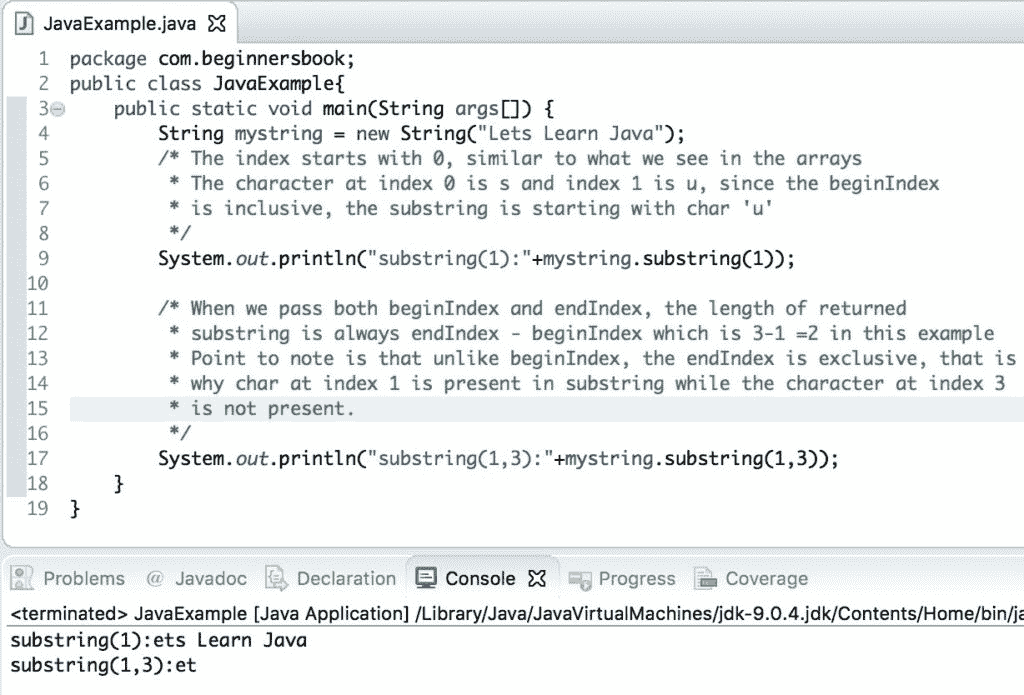原文: https://beginnersbook.com/2013/12/java-string-substring-method-example/
方法substring()返回一个新字符串,它是给定字符串的子字符串。 Java Stringsubstring()方法用于根据传递的索引获取给定字符串的子字符串。这种方法有两种变体。在本指南中,我们将看到如何在示例的帮助下使用此方法。
String substring()方法变体
我们可以通过两种方式使用substring()方法 -
1.当我们只通过起始指数时:
String substring(int beginIndex)
返回从指定索引开始的子字符串,即beginIndex,并扩展到字符串末尾的字符。例如 - "Chaitanya".substring(2)将返回"aitanya"。beginIndex是包含的,这就是索引 2 中出现的字符包含在子字符串中的原因。如果beginIndex小于零或大于String的长度(beginIndex < 0 || > String.length())抛出IndexOutOfBoundsException。
2.当我们传递两个索引时,起始索引和结束索引:
String substring(int beginIndex, int endIndex)
返回一个新字符串,该字符串是此字符串的子字符串。子字符串从指定的beginIndex开始,并扩展到索引endIndex - 1处的字符。因此子字符串的长度是endIndex-beginIndex。 换句话说,你可以说beginIndex是包容性的,而endIndex在获取子字符串时是独占的。
例如 - "Chaitanya".substring(2,5)将返回"ait"。如果beginIndex小于零或beginIndex > endIndex或endIndex大于String的长度,它抛出IndexOutOfBoundsException。
Java String substring()示例
现在我们了解了substring()方法的基础知识,让我们来看一个示例来理解这个方法的用法。
这里我们有一个字符串str,我们使用substring()方法找出该字符串的子串。
public class SubStringExample{public static void main(String args[]) {String str= new String("quick brown fox jumps over the lazy dog");System.out.println("Substring starting from index 15:");System.out.println(str.substring(15));System.out.println("Substring starting from index 15 and ending at 20:");System.out.println(str.substring(15, 20));}}
输出:
Substring starting from index 15:jumps over the lazy dogSubstring starting from index 15 and ending at 20:jump
注意:很多人都很困惑,第二个方法调用中返回的子字符串应该是" jump"而不是" jumps",这是因为返回的子字符串长度应该是endIndex-beginIndex,在我们的例子中,beginIndex是 15,endIndex是 20,因此,返回的子串的长度应该是20-15 = 5。正确的答案是" jump",因为在它之前有一个空格,所以子串" jump"的长度是 5(包括空格)。
为了进一步避免混淆,我正在分享这个方法的另一个例子,这个例子很容易理解。
String substring()方法的另一个例子
public class JavaExample{public static void main(String args[]) {String mystring = new String("Lets Learn Java");/* The index starts with 0, similar to what we see in the arrays* The character at index 0 is s and index 1 is u, since the beginIndex* is inclusive, the substring is starting with char 'u'*/System.out.println("substring(1):"+mystring.substring(1));/* When we pass both beginIndex and endIndex, the length of returned* substring is always endIndex - beginIndex which is 3-1 =2 in this example* Point to note is that unlike beginIndex, the endIndex is exclusive, that is* why char at index 1 is present in substring while the character at index 3* is not present.*/System.out.println("substring(1,3):"+mystring.substring(1,3));}}
输出:


